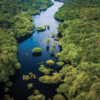As part of the "Borders, circulation, interculturality and human-environment interactions" seminar, the DFR LSH, in collaboration with the LEEISA and MINEA laboratories, is organising a conference entitled "And the bridge created the border. The movement of Brazilian schoolchildren between the banks of the Oyapock". It will be presented by Silvia Lopes da Silva Macedo, Senior Lecturer in Education Sciences at INSPE, UPEC/CIRCEFT-ESCOL, on Friday 2 December 2022 from 6pm to 8pm in room F108.
Tvery day, almost 200 children cross the border between Brazil and French Guiana by canoe to go to school. Brazilian citizens living in the town of Oiapoque, they travel through this 'catchment area' on a daily basis. They speak Portuguese, but also Palikur and Kréol, among other languages, and their schooling is in French, in the schools of Saint Georges.
To enable them to enrol in school and travel across the border river on a daily basis, a flourishing market in services has been set up in the towns of Oiapoque and Saint Georges to provide transport, childcare, meals at lunchtime and school support.
The movement of this school population, as well as that of the French teachers who live on the Brazilian side of the border, allows us to reflect on the forms of occupation and the strategies of the populations in these border areas. How do families move around? Why do they choose to send their children to French schools? And what do teachers think about this movement?
While the town of Saint Georges de l'Oyapock ceased to be "landlocked" with the tarmacking of the N2 road and the construction of the bi-national bridge, the town of Oiapoque is still peripheral to the Brazilian economic and power centres (a situation that will certainly change with the establishment of the Petrobras oil company in Oiapoque). This peripheral status - albeit relative - has contributed to the construction of this 'catchment area', a space where the border disappears beneath the links created by kinship networks and the historical movement of people between the two shores.
Curiously, the border between the two countries reappeared with the construction of the bi-national bridge - a structure designed to unite and catalyse collaboration between Brazil and Guyana. The control and bureaucratisation of traffic became more frequent, making this border line between cities, their citizens and countries (re)appear. "The bridge created the border", said one parent in an interview.
This paper will explore this border zone from the point of view of school traffic. We will seek to understand the reasons, strategies and historical development of this movement across a border that cyclically disappears and reappears over time.





